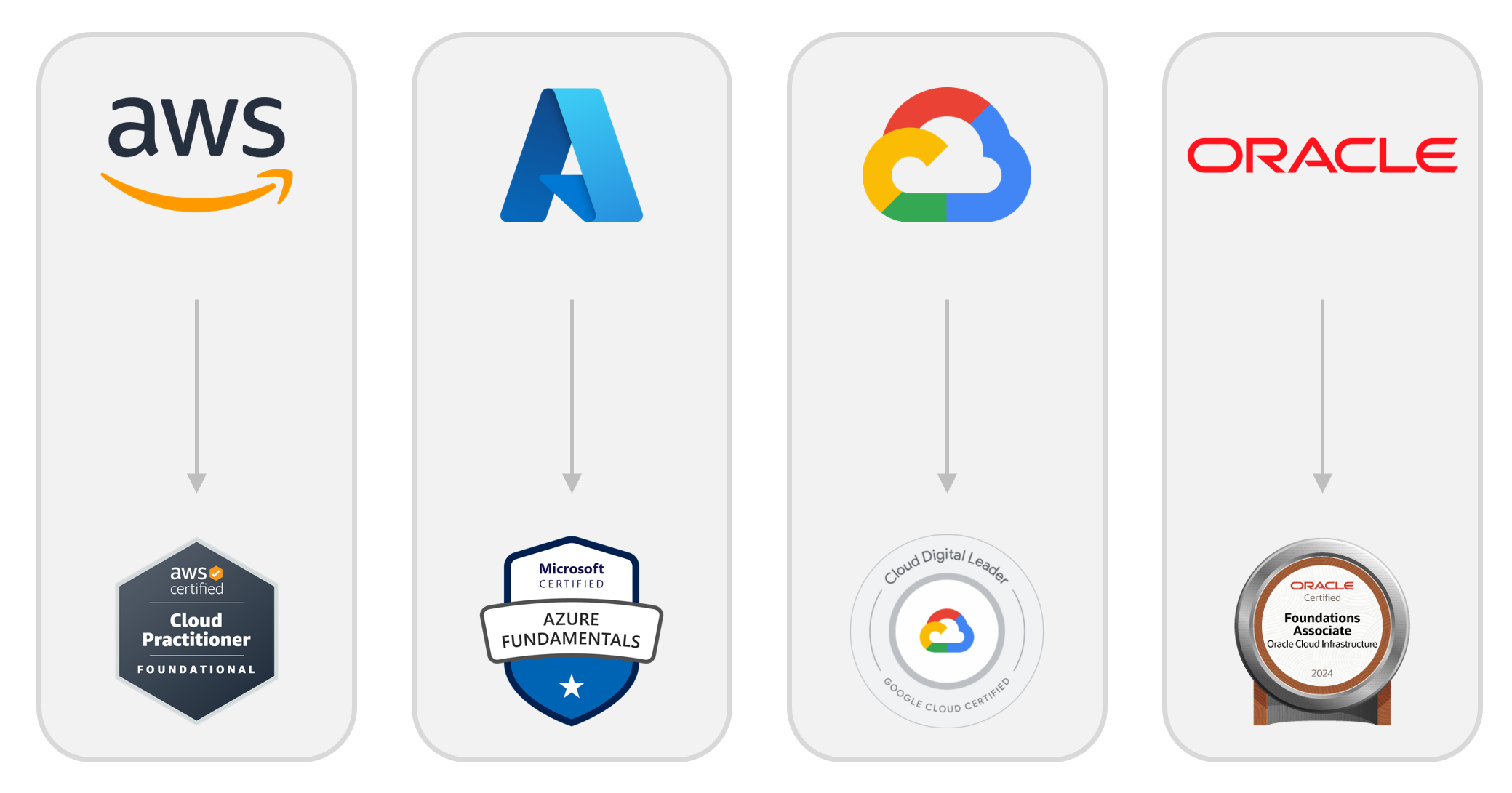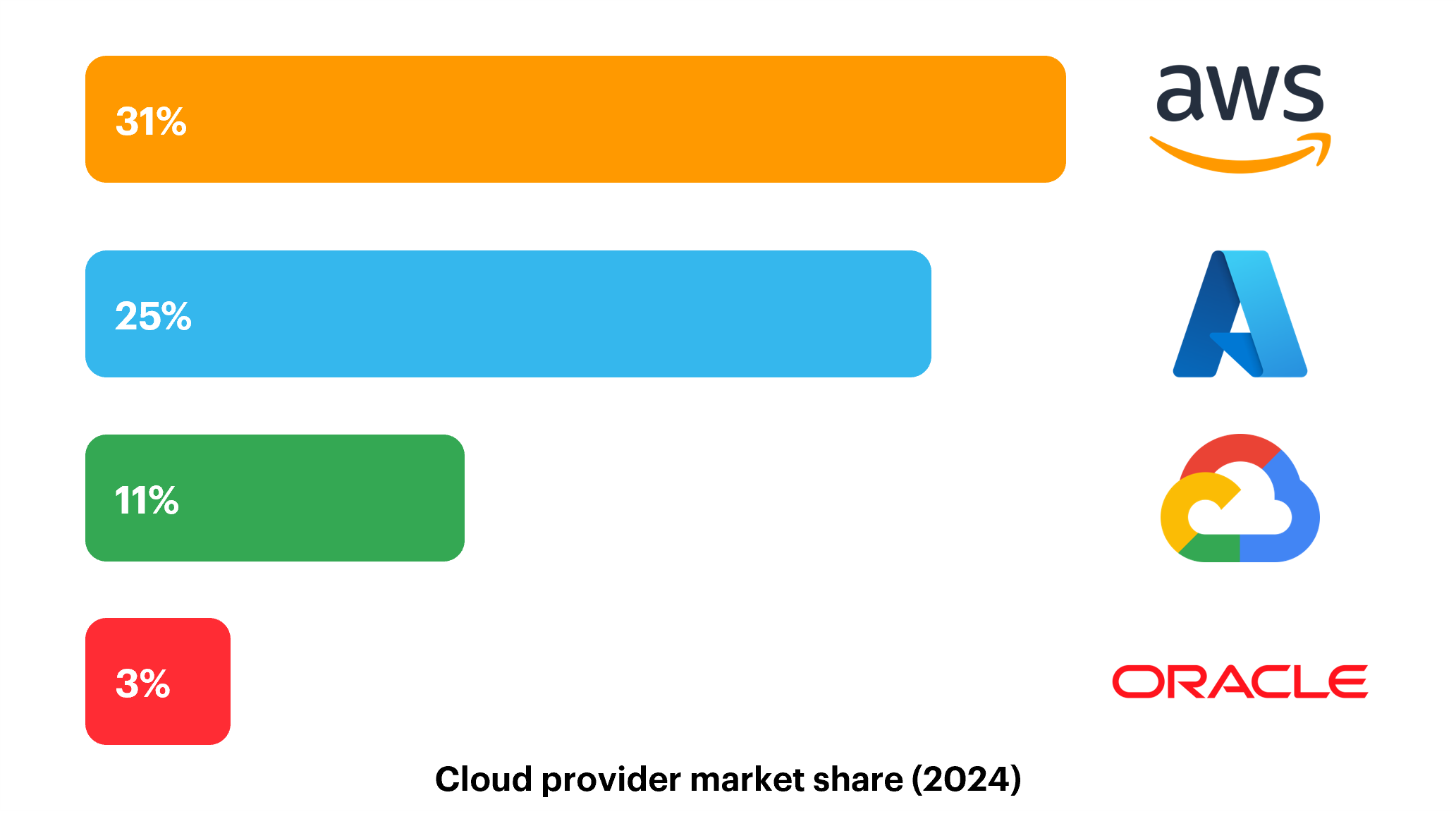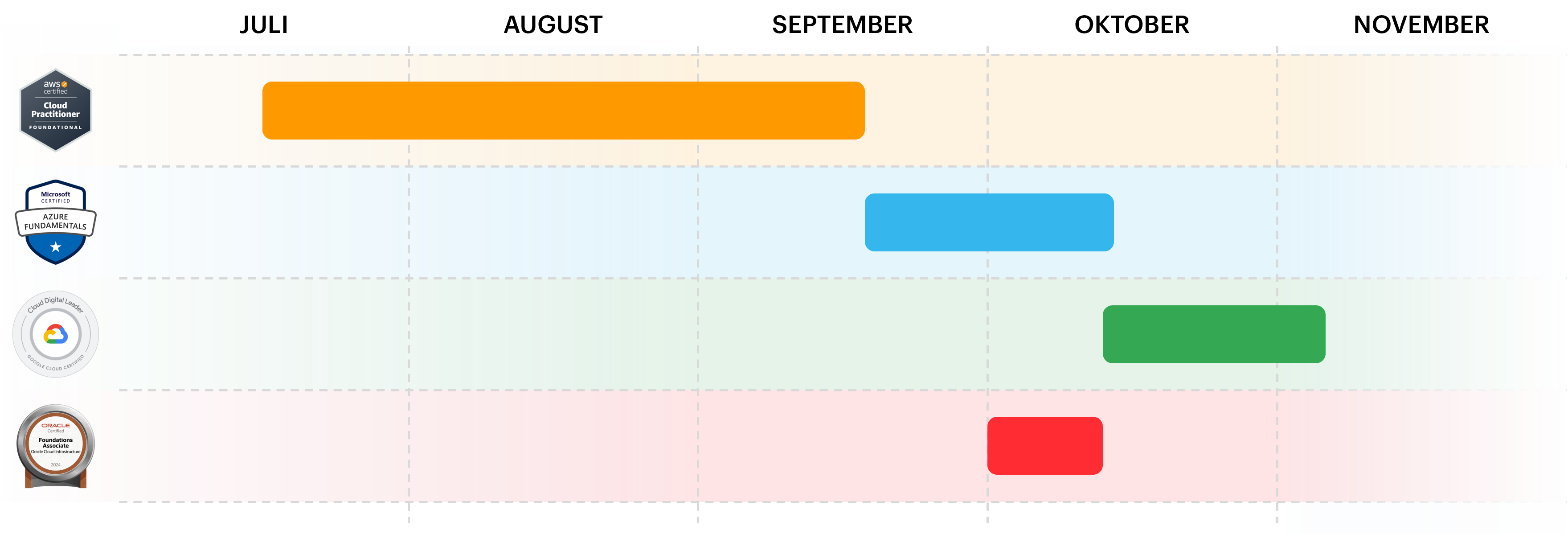How I Earned Four Cloud Certifications in Four Months—and What I Learned Along the Way
 Christoph Schramm
Christoph Schramm
I recently embarked on a journey to build up my cloud computing knowledge by earning foundational certifications from the four largest cloud providers. In this article, I want to share how I completed these certifications, the challenges I encountered, and, most importantly, the insights I gained along the way.
Why Cloud Computing Matters
The rapid evolution of the cloud services industry is redefining how businesses around the world operate, innovate, and scale. In a recent study, McKinsey Global Institute identified cloud services as one of 18 potential arenas of the future that could reshape the global economy in the coming decades.
Increased demand for computing resources due to digital transformation and recent developments in AI research, have led to an ongoing shift from enterprise-owned data centers to cloud services. Hyperscalers like AWS, Microsoft, Google, Oracle, and Alibaba have built datacenters around the world to offer highly scalable, innovative, resilient and secure computing resources to their customers.
Surveys estimate that around 94 percent of enterprises currently use cloud services and 60 percent of all corporate data globally is stored in the cloud. Despite the staggering cloud industry revenue growth in recent years ($32 billion in 2017 to $270 billion in 2023), McKinsey estimates that the technology segment will continue to increase at a similar rate in the coming decades.
Setting the Goal
Since starting my role as a Cloud Advisory Analyst at Accenture earlier this year, I knew that a deep understanding of cloud technologies would not only boost my technical knowledge but also enhance the value I bring to my client engagements. With a background in business management and digital transformation, I have always been passionate about technology’s role in driving efficiency and innovation, and so, the goal was born: acquire foundational certifications from the largest and most well-known cloud service providers. The certifications I focused on are:
AWS Certified Cloud Practitioner
Microsoft Certified: Azure Fundamentals (AZ-900)
Google Cloud Digital Leader
Oracle Cloud Infrastructure Certified Foundations Associate
Each certification represents a unique body of knowledge about one of the four major platforms. Currently, these companies account for about 70 percent of total revenues in the cloud computing sector, and due to network effects, scale advantages, and high barriers to entry, they will continue to play a large role in the foreseeable future.

Essential Resources
Preparing for these certifications required a strategic approach to learning resources. For that reason, I utilized a combination of official prep material from the hyperscalers and additional, external resources. Here’s a breakdown of the resources that helped me succeed:
AWS Skill Builder: Offers foundational courses covering everything from cloud basics to core AWS services, security, and pricing models. Hands-on labs provided real-time practice and allowed me to experiment with AWS services in a guided environment.
Microsoft Learn: Microsoft’s platform offers self-paced learning modules that align directly with their respective certifications. Interactive exercises and virtual labs were especially useful for understanding the Azure platform and getting used to the Azure Command Line Interface.
Google Cloud Training and Skill Badges: Google provides free foundational training for its Digital Leader certification through Google Cloud Skills Boost. The platform’s Skill Badges were great for testing and validating theoretical knowledge through practical labs.
Oracle Cloud Infrastructure Learning: Oracle offers a free learning path for its foundational certifications, which include short videos, written tutorials, and practical labs. This resource helped me quickly grasp Oracle’s unique architecture and enterprise-grade solutions.
Pluralsight: A technology skills platform that contains curated learning paths in alignment with common IT certifications. Especially their simulated exams mirror the format and content of actual certification tests and helped me to assess my exam readiness.
A Cloud Guru: An online learning platform that is owned by Pluralsight and specializing in cloud computing education. It offers courses, hands-on labs, and practice exams across all cloud providers. The practice exams were helpful, with questions similar to the actual exams, in particular for Google’s Cloud Digital Leader certification.
MeasureUp: One of the leading providers of IT certification preparation materials. Their Microsoft Certified: Azure Fundamentals practice test was a great learning resource and very close to the format and content of the actual certification exam.
YouTube: There are many free video courses. I found the ones by freeCodeCamp and John Savill very well structured and easy to follow.
Notion: Used for note taking.
Together, these resources provided a balanced mix of theoretical knowledge and practical application. Leveraging both the official training platforms of the hyperscalers and specialized resources for exam preparation enabled me to gain a deep understanding of each platform and successfully earn my certifications.
Disclaimer: Due to working at Accenture, I was provided with full access to all of these resources. In addition, I received vouchers for all four exams.
Crafting an Effective Study Plan

I knew that balancing a full-time consulting role with ongoing certification preparation would require a solid study plan. Here are some of the strategies I used:
Weekly Goals and Milestones: Breaking down each certification into manageable weekly goals was essential for staying on track and avoiding study fatigue. By focusing on smaller milestones, I could maintain a steady pace and feel a sense of accomplishment along the way.
Diverse Learning Resources: To prepare comprehensively, I used a blend of resources, including official documentation, video tutorials, practice exams, and hands-on labs. I found that the hands-on labs, in particular, were a great way to solidify my understanding of theoretical knowledge.
Consistency Over Intensity: I made sure to dedicate at least one hour everyday to studying, with longer sessions on weekends. This consistent pace allowed me to retain information better and steadily work towards each exam without overwhelming myself.
Online Communities: I joined forums and communities such as Reddit’s r/cloudcomputing and r/azurecertification to engage with others working towards similar goals. This provided me with encouragement and insights into other people’s certification journeys.
Exam Scheduling for Accountability: I found that scheduling exams one or two weeks in the future created just the right amount of pressure. This strategy gave me enough time to prepare thoroughly while setting a clear deadline to keep me on track.
Progress Compounds Over Time: As I progressed, each exam became a bit easier. The foundational knowledge I gained from earlier certifications carried over, with many concepts overlapping across exams. While the first certification took the longest to complete, each subsequent exam felt less daunting due to the familiarity with core topics and cloud principles.
Milestone Achieved: Certification Breakdown
After almost four months of intense studying, note-taking, countless mock exams, and four early morning exam appointments, I successfully passed the Google Cloud Digital Leader Certification, thereby reaching my goal of attaining to attain all four credentials. Following, I would like to break down each certification and highlight the unique aspects and challenges I encountered.

AWS Cloud Practitioner
As the most popular cloud provider by market share, AWS’s foundational certification was my starting point. The AWS Cloud Practitioner certification focuses on cloud essentials like pricing models, the Cloud Adoption Framework, security, and core AWS services. What I found particularly helpful was AWS's emphasis on real-world use cases, which helped me understand the practical applications of each service.
Challenge: The vast number of services can be intimidating. I found focusing on core services rather than trying to memorize everything helpful.
Key Takeaway: Cloud computing is flexible, with different solutions for diverse business needs. Gaining familiarity with these options can help clients make informed decisions.
Microsoft Certified: Azure Fundamentals (AZ-900)
As Microsoft continues to dominate the enterprise software market, I found the AZ-900 certification essential for understanding Azure’s seamless integration with Microsoft products. The course delved into core services like Azure Active Directory, Virtual Machines, and Networking.
Challenge: The integration with on-premises solutions added a layer of complexity, especially in hybrid cloud scenarios.
Key Takeaway: Azure integrates exceptionally well into the enterprise IT environments of organizations that are already invested in the Microsoft ecosystem. Today, more than 95 percent of Fortune 500 companies use Azure global infrastructure. The platform’s strength in hybrid cloud solutions is also noteworthy. Learning to leverage Azure for both on-premises and cloud-based workloads can provide clients with flexible and scalable solutions.
Google Cloud Digital Leader
Google Cloud’s approach to cloud computing is data-centric, which aligns well with its history in search and analytics. This certification was especially useful for understanding cloud transformation in industries focused on data and AI.
Challenge: Google’s terminology and approach to cloud services differ significantly from AWS and Azure. They are focused more on business acumen than on technical knowledge, which required a mental shift.
Key Takeaway: Google’s platform excels in data solutions and machine learning. For organizations interested in AI and data-driven insights, choosing Google Cloud provides significant advantages.
Oracle Cloud Infrastructure Certified Foundations Associate
Although Oracle’s current market share for cloud services is significantly smaller than that of its competitors, it is growing at a rapid pace and making significant strides in the sector. This certification was more niche but allowed me to see cloud infrastructure from a different angle.
Challenge: Oracle Cloud Infrastructure is the newest of the four cloud platforms and was built with a security first approach. Its unique architecture requires a deep understanding of technical details such as networking, cybersecurity and databases.
Key Takeaway: OCI’s strength lies in high-performance computing, complex databases and multicloud deployments. It also offers the most competitive pricing structure, resulting in lower costs for compute and storage services compared to AWS, Azure, and GCP.
Key Takeaways
Although completing these four certifications within four months was challenging, the knowledge I gained was highly rewarding. Here’s a non-exhaustive list of my key takeaways:
Unique Strengths of Each Hyperscaler
While there are many overlaps and similarities across cloud ecosystems, each provider has its own strengths, and understanding them is crucial for recommending the most suitable solution for a given use case. AWS is known for its vast range of services and flexibility, Azure shines with close integration of other Microsoft products and in hybrid scenarios, Google Cloud excels in data and AI, and Oracle focuses on enterprise-level solutions and multicloud deployments. Recognizing these differences enables crafting more precise, effective cloud strategies tailored to specific organizational needs.
Hands-On Experience is Invaluable
While reading and watching video courses can go a long, hands-on labs and practical exercises proved essential for truly grasping how each service works. Engaging directly with cloud resources allowed me to see firsthand how theoretical knowledge translates to real-world applications, especially in more areas such as networking, security, databases and identity management. For anyone pursuing similar certifications, I highly recommend dedicating time to labs, especially those covering intricate services.
There’s a Strong Trend toward Multicloud and Hybrid Cloud Solutions
One of the key insights from this learning journey is the growing shift toward multicloud and hybrid cloud solutions across industries. Companies are increasingly reluctant to rely on a single provider and instead opt for multicloud strategies to avoid vendor lock-in and leverage the specific strengths of each platform. Cloud providers themselves have recognized this shift, and are offering tools and partnerships that make multicloud management more seamless and interoperable, such as Google Anthos, Azure Arc, AWS Outposts and Oracle Database Service for Azure. Understanding the advantages and challenges of multicloud environments as a way to enable organizations to remain flexible, resilient, and able to optimize costs across providers has been invaluable, especially as more businesses are exploring these architectures.
The Power of the Global Cloud Community
Getting involved in the cloud community was incredibly rewarding. Engaging with communities on platforms like Reddit, LinkedIn, and Accenture’s internal networks not only offered valuable resources but also provided motivation and support from like-minded professionals. This sense of community made the journey more enjoyable and opened doors to new perspectives, tips, and shared experiences. Besides pure networking this was also a great way to stay informed on best practices and emerging trends in cloud computing.
Rapid Changes in the Cloud Market
Due to rapid innovation and fluidity in market share, the hyperscalers are in constant competition, with each introducing new services, strategic partnerships, and acquisitions to gain an edge. This dynamic environment means that staying up-to-date on cloud developments is crucial, as today’s leader like AWS and Azure may face stiff competition in the future. Following industry updates and assessing how these changes impact provider strengths and weaknesses has become an essential part of staying relevant in this field.
What’s Next
With these four foundational certifications under my belt, I’m now equipped to provide informed guidance to clients and colleagues about the most common cloud platform and their business applications. I look forward to using my knowledge for driving innovation and efficiency in my role at Accenture and helping clients navigate their cloud journey with confidence. I’m also planning to attain some of the more advanced cloud certifications in the coming months.
To close, I’d like to share a quote from Marc Benioff, CEO of Salesforce:
“The cloud services companies of all sizes…The cloud is for everyone. The cloud is a democracy.” – Marc Benioff, CEO – Salesforce.com
So, if you’re thinking of starting your cloud journey, my advice is to take it one step at a time, focus on hands-on learning, and leverage your network. The cloud landscape is vast and constantly evolving, but with the right approach, you can build a strong foundation that will aid you in any role.
For anyone interested in connecting or learning more about my journey, feel free to reach out to me on LinkedIn.
Subscribe to my newsletter
Read articles from Christoph Schramm directly inside your inbox. Subscribe to the newsletter, and don't miss out.
Written by
